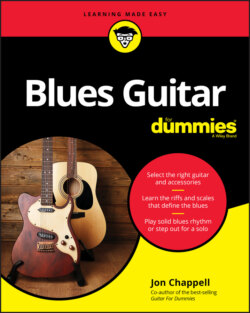Читать книгу Blues Guitar For Dummies - Jon Chappell - Страница 37
The guitarist’s language of melody
ОглавлениеThe blues definitely has a harmonic and melodic language, and even a scale named after it: the 6-note blues scale. If music is described as “bluesy,” it usually means that the melody borrows or enlists notes from the blues scale (nicknamed “blue notes”) rather than the standard major and minor scales that make up other, non-blues styles. Blue notes are the minor third, minor seventh, and flatted fifth (in shorthand, those notes are ♭3, ♭5, and ♭7). Figure 2-1 shows the C major scale (the familiar do, re, mi — and so forth) with the blue notes shown below their unaltered counterparts.
FIGURE 2-1: The C major scale with blue notes.
When discussing scales, you don’t include the octave note, in this case, the second, higher C. That’s why it’s in parentheses. So a major scale is a 7-note scale, though in practice musicians usually include the octave eighth note.
When playing the blues, guitarists incorporate aspects of both the major scale and the blue notes to come up with two new scales of their own: the 6-note blues scale and the 5-note minor pentatonic scale (covered in detail in Chapter 8). Figure 2-2 shows both scales in letter names and in music notation.
If all this talk of scales, intervals, and flat this and that are making your eyes roll, don’t worry. You don’t need to know any of this to play the blues or to even hear it. Plus, you get a scalar workout in Chapter 7 on blues lead!
FIGURE 2-2: The 6-note blues scale and 5-note minor pentatonic scale.
